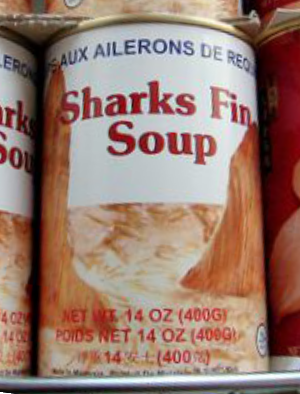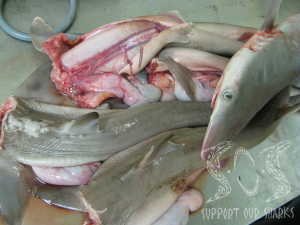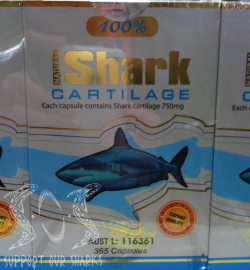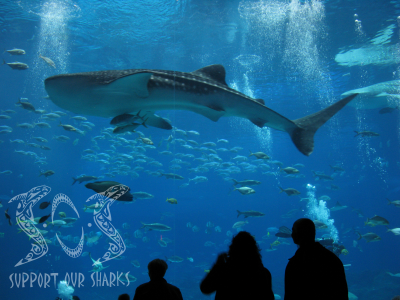Shark
fin soup
 Shark
fins are highly prized for use in shark fin soup, a high status dish
that can sell for over £100 a bowl, especially in Asian countries where
growing wealth has increased demand. As demand is met, sharks become
over-fished, fins are harder to come by and the soup is therefore
even more of a status symbol.
Shark
fins are highly prized for use in shark fin soup, a high status dish
that can sell for over £100 a bowl, especially in Asian countries where
growing wealth has increased demand. As demand is met, sharks become
over-fished, fins are harder to come by and the soup is therefore
even more of a status symbol.
Scientists
estimate that
up to
273 million
sharks are caught
and killed each year, many of them purely for use in
shark fin soup. Hong Kong alone imported the fins of more than
28
million sharks in 1999. Often sharks are caught, their fins cut off
and they are then thrown back into the sea, still alive, where they either bleed
to death or drown: this process is know as Shark Finning. Using DNA, it is now possible to
identify shark
species from their fins, a development which may be significant in
monitoring the impact of this trade.

Demand
for shark meat is booming and it is now possible to buy it in most
major supermarkets. The shortfin mako which is said to provide the
‘best’ shark meat is in high demand, but even more vulnerable
species, such as the porbeagle shark, are also taken.
Fisherman will often claim that they only take species that
are of low risk to extinction and therefore they are fishing
sustainably. However,
given the slow growth and small number of offspring of many of these
target species, it is only a matter of time before they are
classified as vulnerable or
 worse.
Fishermen will then simply move on to the next species and
decimate another population.
worse.
Fishermen will then simply move on to the next species and
decimate another population.
The
trend for increasing demand for sharks may be indicative of the fact
that so many other fish species are declining and that people have
been encouraged to eat fish as a healthy alternative to meat. The
Food Standards Agency, however, has advised against giving children
shark meat to eat because of high levels of
methyl-mercury that can
damage the nervous system.
 Shark
skin and oil
Shark
skin and oil
Shark
skins can be tanned and used as an alternative to leather (for
belts, boots, bags, etc). In theory and on a small scale, this could
be a useful by-product of a sustainable and managed fishery.
Sharks
have traditionally been fished for oil. Squalene is extracted from
shark livers and used as a lubricant and in cosmetic and
pharmaceutical products. It can take up to 3,000 shark livers to
produce one tonne of squalene.
 Shark
cartilage
Shark
cartilage
Sharks
are cartilaginous - they have cartilage instead of bone. The
cartilage is used in traditional medicines and is sold in powder or
capsule form as a cancer treatment. There is no scientific evidence
to suggest that it is in any way effective against the disease and
the 'medicine' can be very expensive. There may, however, be other
benefits in maintaining shark biodiversity to produce artificial
medications, for example, shark cartilage has also been used in the
development of a synthetic skin for burn victims.
Sharks as entertainment
 Typically only a few
benthic species of shark, such as
hornsharks,
leopard sharks and
catsharks had survived in aquarium conditions for a year or
more. This gave rise to the belief that sharks, as well as being
difficult to capture and transport, were difficult to care for. More
knowledge has led to more species (including the large
pelagic sharks) living far longer in captivity. At the same
time, safer transportation techniques have enabled long distance
movement. One shark that never had been successfully held in
captivity for long was the great white. However, in September 2004
the
Monterey Bay Aquarium successfully kept a young
female for 198 days before releasing her.
The Monterey Bay Aquarium has since held a number of White
sharks with different levels of success.
Take a look at the
Monterey Bay Aquarium website
for more information.
Typically only a few
benthic species of shark, such as
hornsharks,
leopard sharks and
catsharks had survived in aquarium conditions for a year or
more. This gave rise to the belief that sharks, as well as being
difficult to capture and transport, were difficult to care for. More
knowledge has led to more species (including the large
pelagic sharks) living far longer in captivity. At the same
time, safer transportation techniques have enabled long distance
movement. One shark that never had been successfully held in
captivity for long was the great white. However, in September 2004
the
Monterey Bay Aquarium successfully kept a young
female for 198 days before releasing her.
The Monterey Bay Aquarium has since held a number of White
sharks with different levels of success.
Take a look at the
Monterey Bay Aquarium website
for more information.
Pollution
The health of the ocean is important for all marine species. Pollution
from human activity often ends up in the sea. Sharks are at the top
of the food chain so they are likely to have a higher concentration
of these toxins that build up in the body fat of their prey. Because
human development and subsequent pollution often occurs in coastal
areas, important shark nursery areas are also at risk.
A
study in Southwest Florida's Caloosahatchee River
showed that newborn bull sharks carry traces of drugs that humans
excrete after taking medicine, or introduce by flushing unwanted
pills down the drains which then make their way to local river
systems. According to the first-ever study of pharmaceuticals in
wild sharks, led by Mote Marine Laboratory and supported by the
Charlotte Harbor National Estuary Program and the National Oceanic
and Atmospheric Administration. Scientists found that the new born
bull sharks had detectable levels of drugs, which at present were
not thought to be of serious concern but could be fatal in the long
term if left unchecked. The bull sharks encounter treated
wastewater near its source as they are one of only a few sharks able
to live in freshwater rivers.
